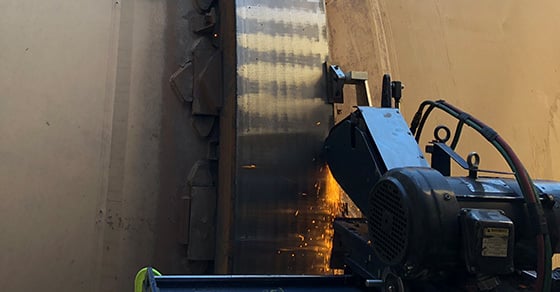Reconditioning or resurfacing of rotary drum tires (riding rings) and trunnion wheels via grinding is one of the most important maintenance procedures carried out on rotary equipment such as dryers, coolers, and kilns.
While restoring these load-bearing surfaces is a common practice, many questions often surround procedure. Below, we’ve answered the most frequently asked questions we receive around tire and trunnion wheel grinding.
Do I really need to correct tire and trunnion wear? What are the consequences of just leaving it?
Rotary drum tires and trunnions (rollers) are often wrongly perceived as isolated components of the rotary drum. On the contrary, as load-bearing surfaces, tires and trunnions set the foundation of the unit’s mechanical stability. As a result, any wear on tires and trunnions has the potential to throw the entire system off balance.
Even wear that is minor at first continues to escalate, affecting several components if left untreated. Wear can cause misalignment, increased drum vibration amplitude, and improper load distribution, all of which put added stress on the mechanical components of the drum, and even the drum itself.
In severe cases, wear may ultimately lead to premature equipment failure.
How do I know if my rotary drum tires or trunnion wheels need resurfacing?
The question is not if tires and trunnions should be resurfaced, but at what point.
Because damage to these surfaces has a compounding effect, addressing signs of wear as quickly as possible is recommended to prevent further damage. Since even wear that appears minimal has an effect on the system, any visible signs of wear on tires or trunnions indicate that resurfacing is necessary.
How long does the grinding process take?
The length of time required to complete tire and trunnion wheel grinding varies depending on the severity of wear and the width and diameter of the surface face, as well as at how many points wear is occurring. It also depends on the capabilities of the service provider.
In cases of minor wear, grinding may be completed in as little as a few hours, while in cases of severe wear, grinding could require anywhere up to a few days. Service providers that can’t grind the equipment in place may require the affected components to be removed and shipped to their facility for machining, which could add several weeks to the timeline.
How long do the results last?
The grinding process yields tires and trunnions in like-new condition, so results will last for as long as the unit remains mechanically sound. However, if process conditions change, the drum falls out of alignment, or other issues arise, load-bearing surfaces again become susceptible to wear.
It’s important to note that it is not normal for resurfaced tires and trunnions to begin showing signs of wear soon after being restored; wear after restoration indicates that the underlying issue has not been addressed and must be resolved to prevent any further damage.
Does the rotary drum have to be shut down for grinding?
Whether or not the unit must be shut down for tire and trunnion grinding depends on the level of wear and the capabilities of the service provider.
How did my tires and trunnions become worn?
There are a number of potential causes of tire and trunnion wear.
Common causes of tire and trunnion wear include a misaligned drum, excessive wheel skewing, contact with fugitive material, the use of oil for lubrication, and more.
What if my tires or trunnions are beyond reconditioning?
Tires and trunnions with wear that is caught early or results in minimal damage is easily reconditioned to a like-new state, but those exhibiting wear greater than a 10% loss in diameter will require replacement. When more than 10% of the diameter is lost, the drum operates on a different slope, which affects retention time and other influential process parameters.
Prior to grinding, FEECO will inspect the amount of wear to determine if grinding is the best solution. If replacement is required, the FEECO Customer Service Team can work with the client to provide replacement units.
Conclusion
Tire and trunnion wheel grinding promotes equipment longevity by keeping rotary drums mechanically sound and in balance, minimizing stress on all components. Since wear often indicates an underlying problem and puts added stress on the machine, signs of wear should be addressed immediately to prevent additional damage.
The cost, timeline, and other factors of the grinding process depend largely on the level of wear and the capabilities of the chosen service provider. As the manufacturer of the industry’s best rotary drums, FEECO is a preferred service provider for rotary drum tire and trunnion wheel grinding, as well as spare parts, maintenance, and repairs. For more information on tire grinding, contact us today!



